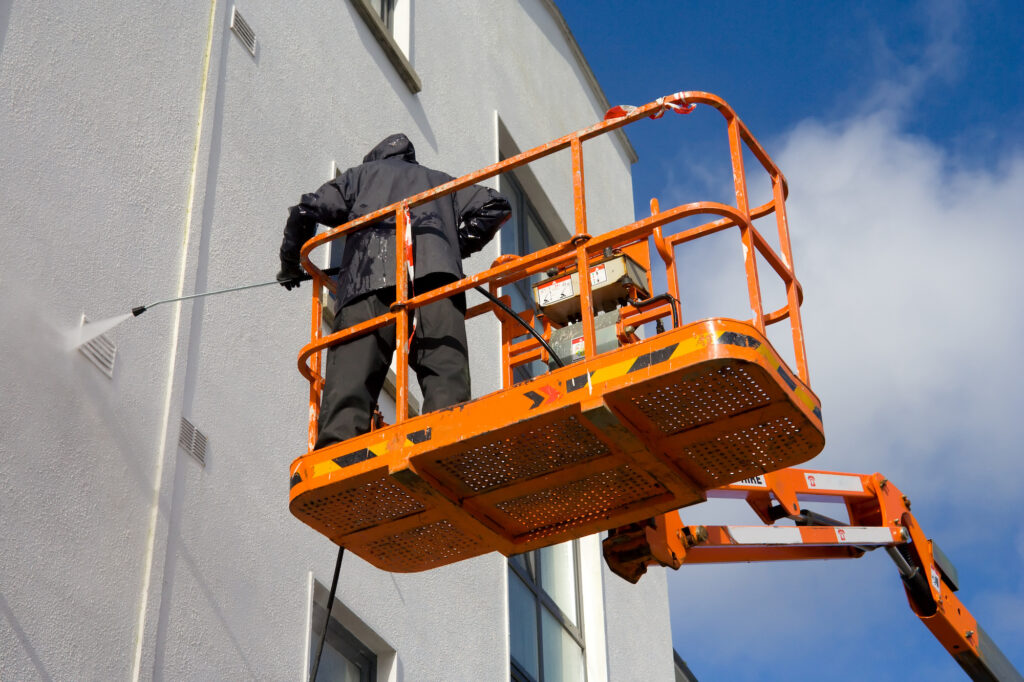Dirt is a part of life. No matter how much we try, it gets through, it accumulates, and eventually, it gets things dirty. Commercial property owners know this all too well, and it’s why pressure washing and sandblasting are two tried-and-true effective methods to combat dirty surfaces in commercial and industrial applications. So what is the difference between these two methods and where are they most often used?
These two eco-friendly ways to clean and prepare surfaces are now the go-to of property owners that seek to clean hard-to-reach places and/or prepare for paint jobs.
Here’s how pressure washing and sandblasting blast your troubles away!
Why Pressure Washing and Sandblasting Will Blow You Away
The key to both of these methods is high pressure and proper technique. The right equipment also makes a critical difference in the overall results, but the concept behind pressure washing and sandblasting is all in the name. In pressure washing, for example, the pump might deliver water pressures at up to 40,000 psi. Sandblasting involves the same concept but includes the added abrasive material that fights an object’s surface to wipe away residue.
Proper equipment is used in both instances to ensure safety and efficiency, and a professional pressure washing or sandblasting service is recommended.
A Blast From the Past — History of Pressurized Washing
Both blasting processes above are descendants of the pressure washing method that first originated in the early 20th century when a Pennsylvania employee discovered that pressurized steam did a good job of cleaning surfaces including greasy garage floors. This man set out to create a contraption that would mix chemicals and the above technique to achieve high levels of cleanliness. It wasn’t long before the car wash industry forced innovation on this front, as people sought to find more efficient ways to clean grease of cars engines and surfaces without causing major damage.
The Pressure Washing Process
Pressure washing is a sophisticated technique that uses pressurized water strategically to clean surfaces; it concentrates a pressurized stream onto a hose and nozzle and is used to wash away particles, paint, surface coatings, etc.
The pressure can be so strong, however, that improper use or incorrect technique can cause divots or dents on the surface, damaging walls, exteriors, and more. Some water blasters also use a vacuum technology that dries as it goes. This isn’t always necessary, as the blast does away with residue easily.
Pressure Washing Benefits
There are many benefits to using pressure washing techniques for cleaning or surface preparation. Depending on the application and task at hand, pressure washing offers a variety of benefits including:
- Allows for efficient cleaning without chemicals or contaminants that can affect surface integrity or paint
- No residue is left behind
- Quick and efficient process that keeps your business running
- It is not necessary to use heat, which can be dangerous in certain settings
The Sandblasting Process
Also known as abrasive blasting, this process uses abrasive material to further clean and prepare surfaces. It can also smooth rough surfaces to make painting jobs much more effective. This method is preferred to clean off corrosion from metals, cars, machinery, structures, and more.
The Sandblasting Benefits
Certain industries benefit greatly from the use of sandblasting processes. The benefits of sandblasting processes including:
- Efficient cleaning technique without leaving behind residue
- The idea for preparing surfaces
- Works faster than pressure washing thanks to the abrasive material
- A good technique for metals
- Can remove rust, scale, or existing coatings
Differences Between the Two Methods
Both of these techniques use high-pressure streams for cleaning, are effective on a variety of surfaces, and more. These two techniques are effective at cleaning but have some differences to note.
- pressure washing is eco-friendly and doesn’t leave behind any residue
- Sandblasting is ideal for metals
- Sandblasting can be both wet or dry
Why are These Methods Ideal for Surface Preparation?
Many commercial buildings and sites often have to contend with large-scale painting jobs. Before adding paint to any surface, that surface should be cleaned of debris and dirt to ensure that the material adheres correctly. Certain materials also require special processes in order to be primed for painting. This includes metals.
So Which Process is Right For Me?
As we’ve mentioned above, both techniques are highly effective in clearing and improving surfaces but have slight differences that might make one better over the other depending on the task at hand. So whether you are removing graffiti from your commercial building or preparing metals for painting, these techniques will get the job done.
Overall, it depends on the project, the material, and time constraints:
- Sandblasting might be a good choice for projects with tight schedules that require pristine surface preparation for painting, as sandblasting can often be a quicker way to clean.
- Each method has a certain degree of customization and modification that can be adjusted to better fit the project.
- If you are painting metal or a rough surface, sandblasting may be a little more efficient.
Clean Safely and Effectively with Pressure Washing and Sandblasting
If you have a commercial property or applications that could benefit from these cleaning methods, look no further. At Texas Enviroblast, not only do we have state-of-the-art equipment but we have trained personnel that know how to use these different methods in the most effective and safe way.
Want more information about these two methods? Texas Enviroblast has your back. Call us today and find out more.
